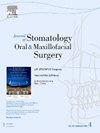Evaluation of dimensional changes of the nasolacrimal canal after rapid maxillary expansion: A cone-beam computed tomography study
IF 1.8
3区 医学
Q2 DENTISTRY, ORAL SURGERY & MEDICINE
Journal of Stomatology Oral and Maxillofacial Surgery
Pub Date : 2024-11-20
DOI:10.1016/j.jormas.2024.102160
引用次数: 0
Abstract
Objective
The aim of this study is to evaluate the nasolacrimal canal dimensionally and volumetrically after treatment in patients who underwent rapid maxillary expansion.
Materials and methods
A total of 19 patients (12 females, 7 males) with maxillary transverse deficiency, who underwent rapid maxillary expansion were included in the study. Cone beam computed tomography images were analyzed to measure the volume, anteroposterior diameter, transverse diameter, length, and angle of the nasolacrimal duct before and after treatment.
Results
The average age of the patients was 13.8 ± 1.69 years. Statistically significant increases in the volume, anteroposterior diameter, transverse diameter, length, and angle of the nasolacrimal canal were observed after treatment for both the right and left sides. No significant difference was found nasolacrimal canal dimensionally and volumetrically except angle on the left and right side of male and female patients. No significant differences were found in the changes between male and female patients.
Conclusion
Rapid maxillary expansion resulted in significant dimensional and volumetric increases in the nasolacrimal canal. Although no prior studies have linked maxillary transverse deficiency to nasolacrimal canal obstruction, the findings suggest that RME may be a viable treatment for nasolacrimal canal obstruction under appropriate conditions.
评估上颌骨快速扩张后鼻泪管的尺寸变化:锥形束计算机断层扫描研究
研究目的本研究旨在评估接受上颌快速扩张术的患者治疗后鼻泪管的尺寸和体积:共有 19 名上颌骨横向缺损患者(12 名女性,7 名男性)接受了上颌骨快速扩张术。对锥形束计算机断层扫描图像进行分析,测量治疗前后鼻泪管的体积、前后径、横径、长度和角度:患者的平均年龄为(13.8±1.69)岁。治疗后,左右两侧鼻泪管的体积、前胸直径、横向直径、长度和角度均有明显增加,但无明显差异。除角度外,男女患者鼻泪管左右两侧的尺寸和体积均无明显差异。结论:快速上颌扩容术导致鼻泪管在尺寸和体积上有明显差异:结论:上颌骨快速扩张导致鼻泪管的尺寸和体积显著增加。虽然之前没有研究将上颌骨横向缺损与鼻泪管阻塞联系起来,但研究结果表明,在适当的条件下,RME可能是治疗鼻泪管阻塞的一种可行方法。
本文章由计算机程序翻译,如有差异,请以英文原文为准。
求助全文
约1分钟内获得全文
求助全文
来源期刊

Journal of Stomatology Oral and Maxillofacial Surgery
Surgery, Dentistry, Oral Surgery and Medicine, Otorhinolaryngology and Facial Plastic Surgery
CiteScore
2.30
自引率
9.10%
发文量
0
审稿时长
23 days
 求助内容:
求助内容: 应助结果提醒方式:
应助结果提醒方式:


